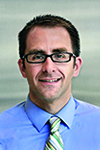

by Cameron Macht and Luke Greiner
March 2025
Believe it or not, educational leaders often let us present labor market information to high school students. Our Regional Analysts stand in front of sophomores, juniors and seniors and try to explain the importance of career exploration. While we'll even do this in individual classrooms, some of the best opportunities for us include large events like the Southwest Minnesota Career Expo, an annual event that hosts nearly 2,000 students from school districts within the 18-county region across two days and two locations.
According to the website, "Since 2002, a number of education and workforce agencies, along with regional businesses, have cooperated to provide regional 'Career Exploration Days' for high school students. Today the event has evolved into a highly interactive 'Career Expo'. Hundreds of business, agency and education volunteers work together to provide this opportunity for high school students, adult basic education students and various SW MN Workforce Center participants ... nearly 2,000 students participate annually, and each year the number and type of interactive exhibits expand to better meet the needs of schools and students from the region."
Similarly, Central Minnesota has built up and developed the Exploring Potential Interests and Careers (EPIC) Student Day, which brings together as many as 4,500 area high schoolers to attend this "annual, hands-on career exploration event composed of interactive experiences simulating career activities students may pursue through educational paths."
At these events and other smaller scale opportunities, we have the chance to present career information, and also ask the students questions about their career interests, future plans, and perceptions about work and life. We use PollEverywhere to get responses from students – yes, we know it's dangerous to have students take out their cell phones while we're trying to keep them interested in labor market information! We've been doing this for a while, so we've gotten pretty good at keeping their attention.

Luke Greiner presents to a group of students in Marshall at the Southwest Minnesota Career Expo. Photo from the Southwest/West Central Service Cooperative

Luke Greiner presents to a group of students in Worthington at the Southwest Minnesota Career Expo. Photo from the Southwest/West Central Service Cooperative
In our presentations at these events last year, students from across Central and Southwest Minnesota were asked what type of job they are most interested in, and we got roughly 1,500 responses. In line with historical trends for this question, the highest interest was in Health Sciences and Human Services, reflecting the desire of more than a quarter of all students. Despite the turmoil of the healthcare sector during the COVID-19 Pandemic, student interest has rebounded to levels we saw in the 2010s.
Slight variations exist across different regions, reflecting the dominant and popular employers that students are familiar with. For instance, interest in the Agriculture, Food and Natural Resources career cluster was nearly double in Southwest Minnesota compared to Central Minnesota. However, the share interested in Health Sciences and Human Services was nearly identical in both regions, as were most other responses. Other, not sure or self-employment ranked high in both places as well, which is to be expected with most respondents being in their sophomore year of high school.
For space and clarity, Manufacturing and STEM were combined as a career field for the survey, yet only 7% of students selected that area as their job of choice. In many communities across Minnesota, especially in Southwest and Central, Manufacturing is either the largest or second largest employing industry, and great lengths are taken and resources spent bolstering interest in STEM. In 2024, Manufacturing accounted for 17.4% and 14.7% of total employment in the regions, respectively, or about one in every six jobs, yet fewer than one in every 14 students expressed an interest in this major field.
To some degree, these data can help school districts provide curriculum that reflect information gaps that students might have of regional economic opportunities. The labor market is still relatively tight and helping students understand the types of careers available in their local area can help shape their career interests. This, sometimes conflicting, approach is meant to provide content that interests students, balanced by content that informs students of what realistic economic opportunities exist (see Figure 1).

Perhaps even more pertinent to helping students find their path is providing information on how they should be preparing while in high school. Figure 3 illustrates the aspirations of 10th grade students following high school graduation according to their survey responses. In 2024, half of students surveyed indicated they plan to attend a 4-year college, which is still the largest share, but is down substantially from previous years when it was common for 60% of students to state that they planned on going to a university. The share interested in attending a 2-year community or technical college grew by 4 percentage points since 2017.
However, the largest shift in student's plans was their desire to get a job following high school graduation. In 2024, 16% said they plan to get a job, roughly equal to the number that plan to pursue a 2-year degree, and four times as prevalent as in 2017 (and most years in the 2010's).
These intentions can be compared to data from the Statewide Longitudinal Education Data System (SLEDS), which tracks student data from pre-kindergarten through completion of postsecondary education and into the workforce. In the past, these indicated plans didn't align as well with the realized post-high school pursuits. However, it's likely that by 2024 many more high school sophomores, juniors and seniors are more realistic about what they will actually do after graduation.
It's difficult to measure the accuracy of their indications because SLEDS shows that 30% of students in Southwest Minnesota enroll at a 2-year or 4-year college outside of Minnesota, nearly the same amount that enroll within Minnesota (30%). Enrollments outside of Minnesota are not disaggregated further to know whether students landed at a 2-year or 4-year college. In other areas of the state, students typically indicate they plan to go to a 4-year college at higher rates than they actually do, and they downplay the likelihood that they might attend a 2-year college.
According to enrollment data for the Southwest/West Central Service Cooperative area, 60% of high school graduates in 2023 immediately attended college in the fall. That was down from 68% as recently as 2018, and the tight labor market and myriad job opportunities available to students encouraged graduates to immediately go to work. For 2023 students, 26% were employed rather than in school in the fall after graduation, with the largest number employed in Trade, Transportation & Utilities (28%), Education & Health Care & Social Assistance (24%), Leisure & Hospitality (17%) and Manufacturing (12%). Despite lower rates of enrollment in higher education, students opting to join the labor force and work full-time have enjoyed increasing demand for their talents. Wages in the first year following high school graduation for those who worked full time (35+ hours/week) grew 37% from 2018- 2023, far outpacing inflation (21%), and the overall private sector wage growth of all employees (23%).
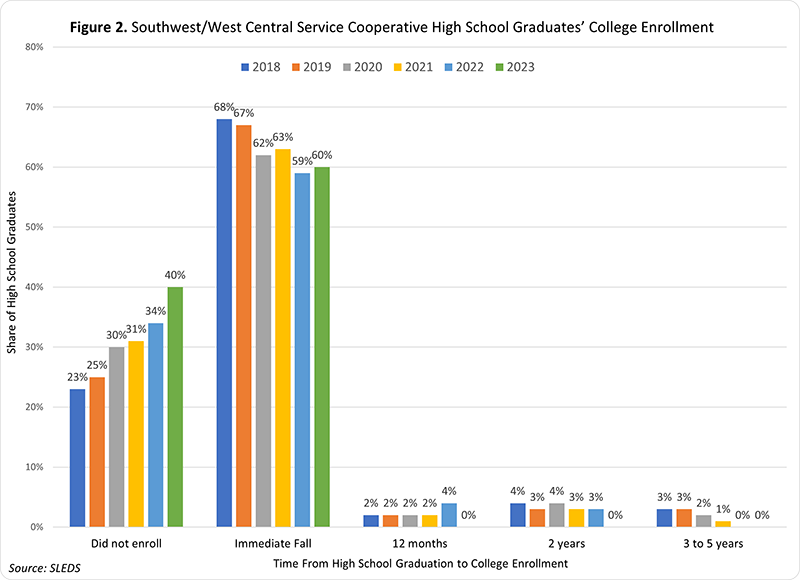
To that end, opportunities to explore careers and learn about economic opportunities in the Southwest region have increased since 2017 thanks to a regional collaboration to bring back Career and Technical Education (CTE) called LYFT. The survey in Figure 3 represents students from Southwest Minnesota, however there are numerous initiatives across Minnesota to rebuild CTE opportunities for students, so results would likely be similar in other regions.
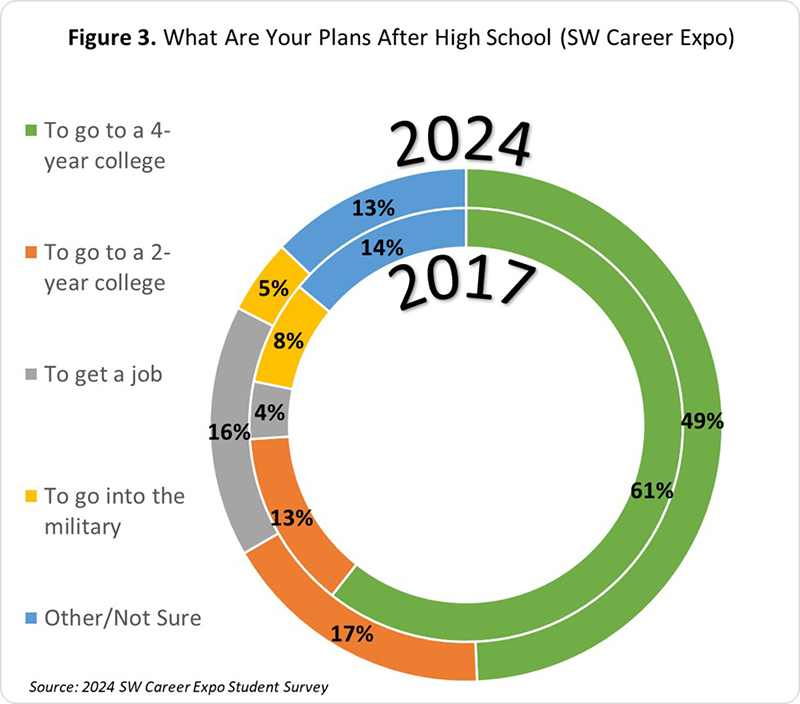
As students have more opportunities to learn value-added skills and explore careers, it seems to be helping expand their perceptions of what is needed to succeed in the economy. For instance, even though the share of students who still aren't sure of their path by 10th grade hasn't changed, those that do have a plan in mind are more realistic. It's not necessarily bad that 13% of high school sophomores aren't sure what they want to do or have a different plan not listed. After all, one of the best benefits of learning about careers early is finding out that a career of interest might not be a good fit. This information, if gained early on in high school, provides an opportunity for students to pivot toward a different path and expand their exploration horizon.
As the saying goes, "you don't know what you don't know." In order to be excited and engaged on a path to a type of career, students must know that the career exists. For some types of occupations, there are plentiful opportunities for students to learn and engage with these careers through CTE courses and events like the Southwest Minnesota Career Expo and EPIC.
Figure 4 shows that many students are just starting their career exploration process, and several of them have a narrow view of how best to explore. Forty percent of respondents to the question this year said that they only explore careers that they're already interested in, whereas only 13% seek out information about different careers. The remaining 47% of respondents are in various stages of getting started exploring careers, including 30% who said they are interested but haven't taken any action yet.
With 40% of students exploring only careers they are already interested in, it's very likely that they haven't viewed the wide range of opportunities available. On one hand, it's terrific that they are interested in specific careers, but on the other, it can still be beneficial to learn about careers they might not even be aware of. After all, there are roughly 800 different occupations to choose from, assuming they might have not discovered their dream job by 10th grade.
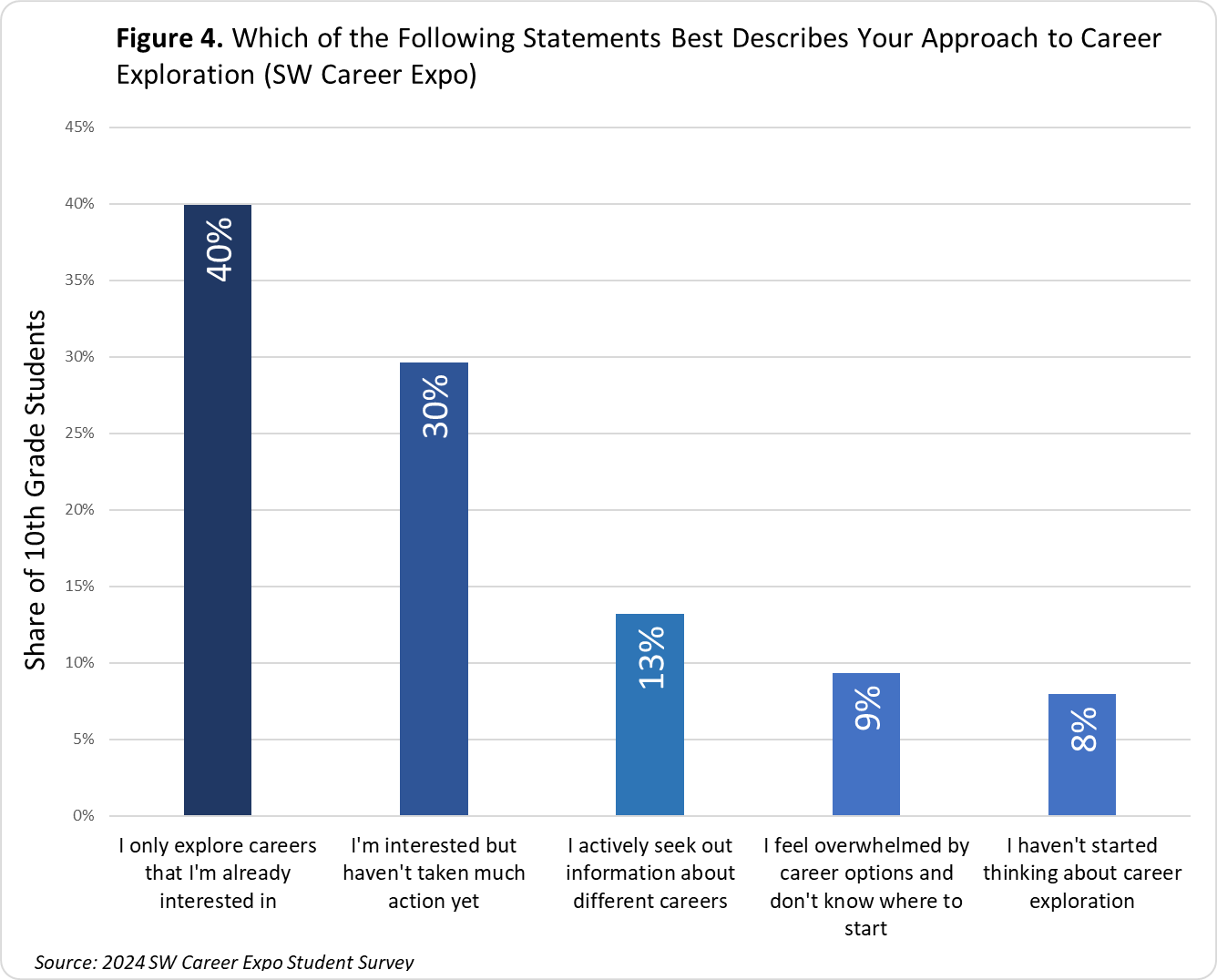
Another question we asked students for the first time this year regards what type of work environment they might prefer. While more established, mid-career workers might have different preferences, the students we polled didn't have a strong consensus. About 30% of students thought they would like to work outdoors or in the field, and another 29% were interested in hybrid work – a mix of office and remote work – and another 6% wanted to work from home. Only 15% preferred a traditional office setting, while 20% didn't have a clear preference (Figure 5).

The final question we asked this year goes back to a familiar theme – in fact, we've written about it before (Tapping Homegrown Talent, September 2018) and continue to be amazed by the students' responses. While we sometimes hear from adults in the region who believe that students can't wait to leave, a much higher percentage actually want to stay. In 2024, 40% of students in Southwest Minnesota stated that they would like to live in their hometown or somewhere near to it. Another 29% said that they would be interested in living in a rural place somewhere else. The final 31% indicated they wanted to live in the Twin Cities or a large city somewhere else (Figure 6).
Again, these results might run counter to the popular narrative that "kids just want to leave." With 70% of students from the Southwest Minnesota Career Expo indicating they want to remain in their area or perhaps move to a rural place somewhere else, it seems that they have mostly enjoyed their communities. Students who show some desire to remain in their region, wherever that may be, would hopefully be met with enthusiastic support from businesses and teachers who likely also want them to stay.
The Minnesota State Demographic Center recently published "An Analysis of Migration Trends and Patterns in Minnesota", which shows that "about 30% of all domestic migrants are young people between the ages of 15 and 29 years. The largest net losses of any age occur between ages 18 and 19 years when many young adults move away to attend college. While a fair share of college students return to Minnesota after completing their degree in another state, the net losses are not fully countered in the older age groups." As noted earlier, SLEDS data show that 30% of students in Southwest Minnesota enroll at a college outside of Minnesota, nearly the same amount that enroll within Minnesota (30%). The report states that "Policies designed to reach young adults as they make important migration decisions could make a greater impact than policies taking a more blanketed approach to all possible movers."
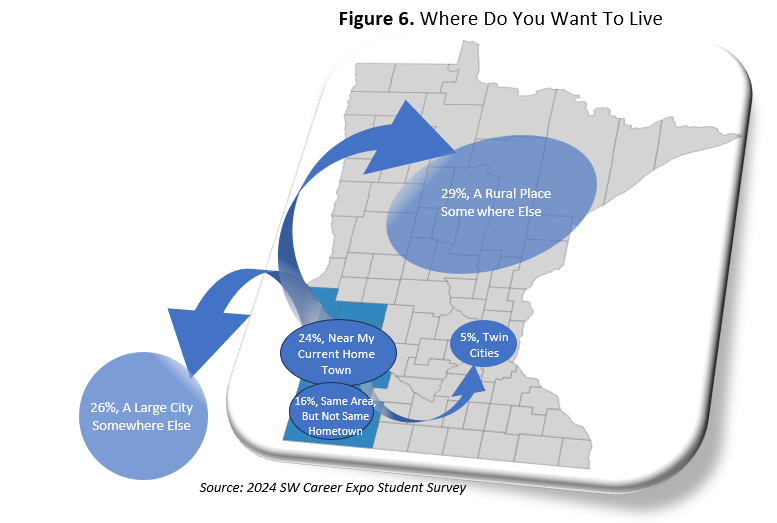
The ability for employers to connect with students has gained traction over the last decade through the dedication of champions and leaders across the state. Eriann Faris is one such champion in Southwest Minnesota, where she works as the Career & Technical Project Coordinator for the Southwest/West Central Service Cooperative. Faris continues to work tirelessly on these projects, and, in her own words, her mission is clear: "Opening the doors for students by connecting them with local employers and exploring the various opportunities available locally. It's a chance for students to explore, ask questions and gain insights that can help shape their future paths with confidence."
The interwoven story of high school students and economic development perpetuates in classrooms and CTE activities across Minnesota. In a tight labor market, high school students are an extremely important source of future workers. Knowing what they think of the economy, their community and how they want to learn about it should be taken seriously by anyone who wants to ensure that education and workforce initiatives align with students' aspirations and regional economic needs.